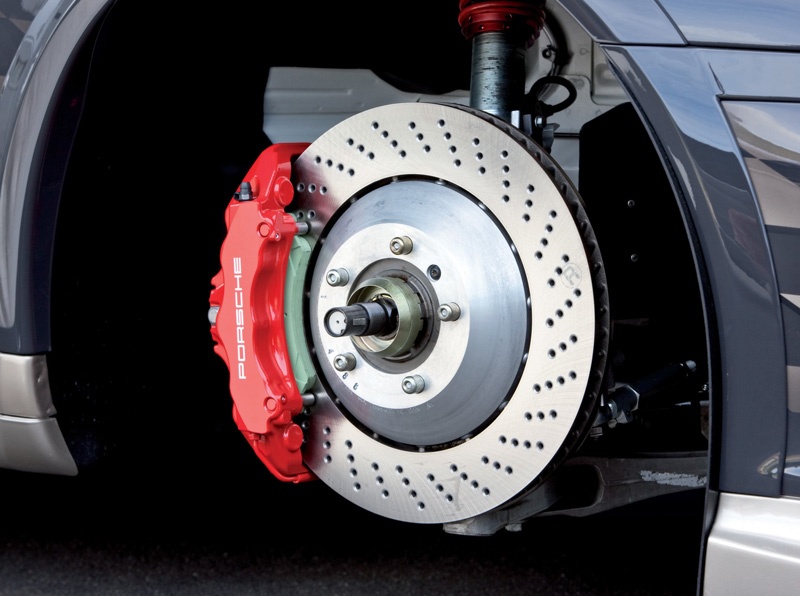Brake Lines:
The brake lines are the lines that run underneath your car from the master cylinder in your engine compartment to all four tires. If your car has low brake fluid levels, it generally indicates a leak somewhere in your wheel cylinders or your brake lines.
Ideally, you would put your car on a hydraulic hoist so you can walk underneath it to check the brake lines, but if you don’t have one available, you can perform the inspection by jacking the car up, one wheel at a time, and putting jack stands under the car. You can then inspect the underside of the car using a flashlight or work light.
1. Locate the brake lines
The brake lines are connected to each wheel at the brake caliper (the “clamp” over the disc brake), and run into the engine compartment where they connect with the master cylinder. Brake lines can be steel, or rubber, or a combination of both.
2. Check for leaks
Run your hand down each brake line, looking for leaks. If you find any moisture, the brake lines will need to be replaced. Brake fluid is clear and sometimes difficult to see at first glance, so keep a sharp eye out. Most leaks occur at the wheel cylinders where they connect to the lines.
3. Other Warning Signs
If rubber brake lines are cracking or flaking, it’s a sign that they need to be replaced. Rubber lines should also be dry and firm—if they are sticky, soft, spongy, or worn, they will require replacement. Streaks of dried fluid also indicate that leakage is occurring. If your lines have some rust, gently sand them off and see if there are any thin areas on the lines—if an area is thin, there’s a good chance that it may leak later.
Replacing Brake Lines
If you need to replace a brake line, be sure to get a brake line that is the same length as the brake line you’re replacing. To replace the line, follow these steps:
1. Remove the tire where you are replacing the line for easier access.
2. Unscrew the brake line from the line fitting closest to the master cylinder.
3. Remove any mounting bracket clips (these are the brackets that hold the line in place).
4. Disconnect the brake line from the brake caliper.
5. Loosely attach the new brake line to the caliper.
6. Reinstall bracket clips with new hose.
7. Attach other end of hose to the line fitting.
8. Tighten all connections.
9. Bleed all air from the brake system (for more details, see the Bleeding Your Brakes section).
10. Test drive the vehicle to ensure that everything is working normally.
Disc Brakes and Pads:
Disc brakes work using a simple system: brake pads contained within the caliper (the clamp-like object around the brake rotor, or disc) apply pressure to the rotor and slow the car when you press the brakes. As the pads and rotor experience wear and tear, they need periodic rebuffing or replacement. Fortunately, inspecting and maintaining these items is relatively easy. Just follow the steps below.
Tools you’ll need:
– Six-point wrench
– Replacement pads (if necessary)
– Jacks and jack stands
– Strong wire or bungee cord
– Set of new brake pads (even if you don’t need to replace them now, it’s good to have a set around for comparison purposes)
– Brake pad grease (usually comes in packets)
1. Before inspection, make sure your vehicle hasn’t been driven for an hour or two—the caliper can be hot if you’ve just been driving.
2. Raise one end of the vehicle on jack stands. If you loosen the lug nuts on the wheels just a bit before raising the car, it usually makes the process easier.
3. When your auto is jacked up and stabilized, remove a wheel and give the brake disc an initial inspection—most calipers have an “inspection hole” where you should get a good view of the disc’s thickness. If the disc shows signs of uneven wear, you will need to take it to a professional to see if it can be reground or needs to be replaced.
4. To inspect the brake pads, you will need to remove the caliper from the disc by disconnecting its mounting bolts using your six-point wrench. Secure the caliper to the car and away from the disc using a strong wire or bungee cord (be sure not to hang it by the brake hose).
5. The brake pads are inside the caliper, and are held in place by either bolts or clips, depending on your vehicle. Remove all bolts and clips and slide the pads out from inside the caliper. If the pads are worn down (less than ¼” thickness), replace them with new ones. When installing the new pads, lubricate the back of the pads with the brake pad grease.
6. While the caliper is away from the disc, take a closer look at the disc itself. Remove any glaze from the disc surface by running a sandpaper across it in a swirling motion. If the disc has any grooves in it, it will need to be inspected by a mechanic. Sometimes discs can be reground, but they may need replacement.
7. When your disc and brake pads are ready to go, fit the disc back onto its rotor and retighten all lug nuts and screws. Reconnect the caliper to the disc with its mounting bolts, and replace the wheel.
8. Follow steps 1-7 for all other wheels if necessary, and when finished, lower the car and remove jacks.

Things you can do to make a good brake maintenance
by
Tags:
